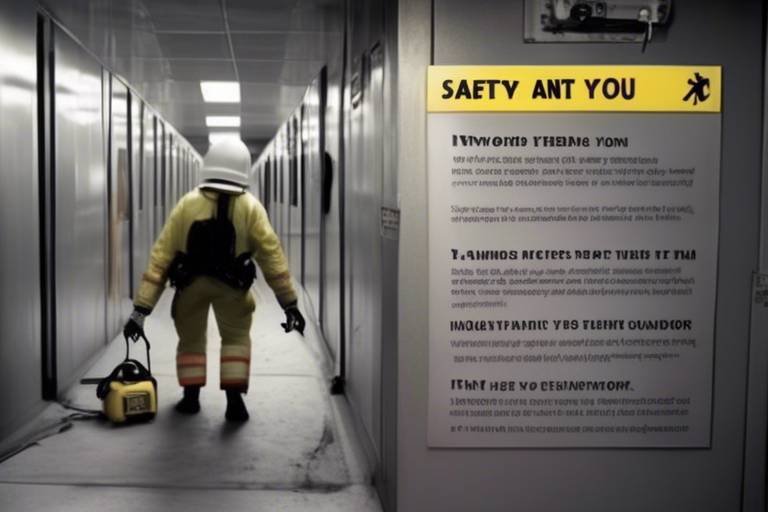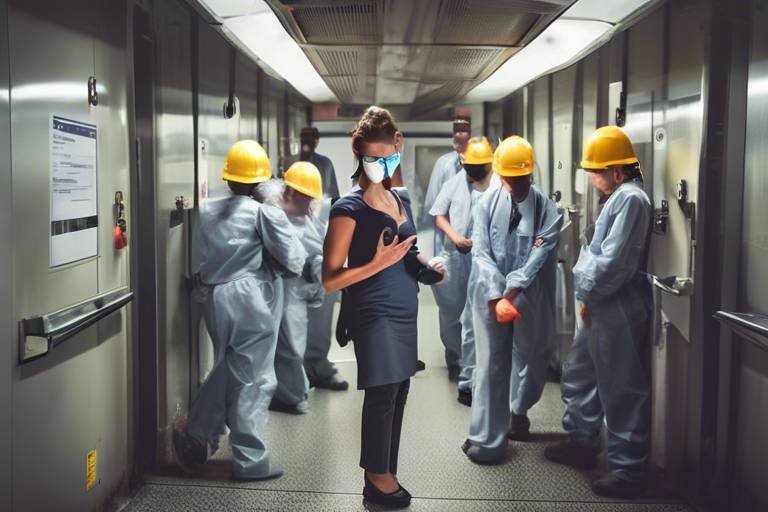Why the Study of Human Behavior is Essential for Safety Measures?
The study of human behavior is not just an academic exercise; it is a cornerstone of developing effective safety measures across various sectors. When we think about safety, we often focus on protocols, equipment, and regulations. However, the reality is that safety is fundamentally about people — their actions, reactions, and decision-making processes. Understanding human behavior allows organizations to craft safety measures that resonate with individuals' natural instincts and inclinations. This understanding leads to increased compliance, better risk assessment, and ultimately, a safer environment for everyone.
Imagine trying to navigate a maze blindfolded. You might bump into walls, take wrong turns, and generally struggle to find your way. This is akin to how organizations operate when they ignore the human element in safety protocols. By studying human behavior, we can remove the blindfold and illuminate the path toward effective safety practices. It’s not just about telling people what to do; it’s about understanding why they do what they do, which is essential for creating an environment where safety is prioritized.
Moreover, human behavior influences how safety measures are perceived and implemented. For instance, if employees feel that safety protocols are too rigid or impractical, they may circumvent them, leading to increased risks. On the other hand, when safety measures are designed with a deep understanding of human behavior, they are more likely to be embraced and followed. This alignment can significantly reduce accidents and enhance overall safety culture within organizations.
In various sectors, from manufacturing to healthcare, the implications of understanding human behavior are profound. In manufacturing, for example, workers may be exposed to hazardous conditions. A safety measure that considers their behavior — such as fatigue levels or their tendency to take shortcuts — can lead to the design of more effective interventions. Similarly, in healthcare, understanding how medical staff react under pressure can inform better safety protocols, ultimately protecting both patients and healthcare providers.
In conclusion, the study of human behavior is essential for developing safety measures that are not only effective but also sustainable. By focusing on the human element, organizations can create safety protocols that are intuitive, practical, and widely accepted. This approach not only enhances compliance but also fosters a culture of safety that permeates the entire organization. After all, safety is not just a set of rules; it is a collective mindset that prioritizes the well-being of every individual involved.
- Why is understanding human behavior crucial for safety measures?
Understanding human behavior helps tailor safety measures that align with people's instincts, increasing compliance and effectiveness. - How do cognitive biases affect safety practices?
Cognitive biases can lead to poor decision-making regarding safety, making it essential to recognize and address these biases in training. - What role does leadership play in creating a safety culture?
Leadership sets the tone for safety culture by modeling desired behaviors and encouraging open communication about safety concerns. - How can technology improve safety measures?
Technology must be designed with a human-centric approach to ensure it is user-friendly and enhances compliance with safety protocols.

The Importance of Understanding Human Behavior
Understanding human behavior is not just a nice-to-have; it’s a critical necessity for any organization aiming to enhance safety measures. Imagine trying to build a bridge without knowing how people use it. You’d end up with a structure that might look great on paper but fails to accommodate the real-world dynamics of human interaction. This is precisely why delving into the intricacies of human behavior is essential for crafting safety protocols that resonate with individuals on a personal level.
When organizations take the time to understand how people think, feel, and react, they can tailor their safety measures to align with those natural inclinations. For instance, if a company recognizes that employees often underestimate risks due to past experiences, they can implement training that specifically addresses this tendency. This approach not only enhances compliance but also increases the overall effectiveness of safety protocols.
Moreover, understanding human behavior facilitates the identification of barriers to compliance. People are often resistant to change, especially when it comes to adopting new safety measures. By recognizing the psychological factors at play—such as fear of the unknown or a lack of perceived value in the safety protocols—organizations can design interventions that are more likely to be embraced by their employees. This might involve creating engaging training sessions or utilizing real-life scenarios that illustrate the importance of safety in a relatable way.
Another vital aspect is that understanding human behavior can lead to better communication strategies. If safety messages are delivered in a way that resonates with employees—taking into account their emotions, motivations, and potential biases—those messages are more likely to be received positively. For example, instead of merely stating the rules, organizations could share stories of how adherence to safety protocols has saved lives or prevented accidents. This storytelling approach can evoke emotions, making the message more impactful.
Furthermore, behavioral insights can help organizations develop a more proactive safety culture. When employees feel valued and understood, they are more likely to engage in safety practices and communicate concerns openly. This creates a feedback loop where safety measures can be continuously refined based on real-world experiences and observations, leading to a more resilient safety framework.
In summary, understanding human behavior is not just about improving compliance; it’s about creating a holistic safety environment where individuals feel empowered and connected to the protocols in place. By considering the psychological and emotional aspects of safety, organizations can craft measures that not only protect but also inspire a culture of safety that resonates throughout the entire workforce.
- Why is understanding human behavior crucial for safety measures?
Understanding human behavior allows organizations to tailor safety protocols that resonate with people's natural instincts, enhancing compliance and effectiveness. - What role does communication play in safety measures?
Effective communication, informed by an understanding of human behavior, ensures that safety messages are relatable and impactful, leading to better adherence. - How can organizations create a proactive safety culture?
By valuing employee feedback and fostering open communication about safety concerns, organizations can build a culture where safety is a shared priority.

Behavioral Psychology and Safety
When it comes to ensuring safety in any environment, understanding behavioral psychology is not just beneficial; it's essential. This branch of psychology delves into how individuals think, feel, and act in various situations, providing invaluable insights that can shape effective safety measures. Imagine walking into a workplace where safety protocols are not just rules but are embraced as part of the culture. This transformation is possible when we leverage the principles of behavioral psychology.
One key aspect of behavioral psychology is the recognition of psychological triggers. These triggers can significantly influence how individuals respond to safety measures. For instance, if employees feel that safety protocols are overly restrictive or unnecessary, they may become resistant to following them. By understanding what motivates people—whether it’s a sense of security, peer influence, or personal responsibility—safety professionals can craft interventions that resonate with these motivations. This approach leads to a more engaged workforce that is likely to follow safety protocols diligently.
Moreover, behavioral psychology helps safety experts identify patterns in human behavior that can lead to unsafe practices. For example, consider the common tendency for people to underestimate risks, particularly in familiar environments. This phenomenon, known as normalization of deviance, occurs when individuals become accustomed to small deviations from safety protocols, gradually leading to more significant risks. By recognizing this behavior, organizations can implement targeted training programs that highlight the importance of adhering to safety standards, regardless of how routine a task may seem.
Another fascinating aspect of behavioral psychology is its focus on reinforcement. Positive reinforcement can be a powerful tool in promoting safe behavior. When employees are rewarded for following safety protocols—be it through recognition, incentives, or a simple thank you—they are more likely to continue those behaviors. This creates a cycle of positive reinforcement that can significantly enhance overall safety culture within an organization.
To further illustrate the impact of behavioral psychology on safety, consider the following table that summarizes key psychological principles and their applications in safety measures:
| Psychological Principle | Application in Safety |
|---|---|
| Psychological Triggers | Design safety measures that align with employee motivations. |
| Normalization of Deviance | Implement training to emphasize adherence to protocols. |
| Positive Reinforcement | Reward safe behaviors to encourage compliance. |
In conclusion, the intersection of behavioral psychology and safety is a dynamic field that holds the key to creating safer environments. By understanding how people think and behave, organizations can develop more effective safety measures that not only comply with regulations but also resonate with the individuals who must follow them. This understanding fosters a culture of safety that is proactive rather than reactive, ultimately leading to a safer workplace for everyone.
- How does behavioral psychology influence safety measures?
Behavioral psychology provides insights into human behavior, helping organizations tailor safety measures that resonate with employees' motivations and instincts. - What are some common psychological triggers related to safety?
Common triggers include fear of injury, peer influence, and the desire for recognition and reward for safe behavior. - How can organizations promote a strong safety culture?
By engaging employees in safety practices, providing positive reinforcement, and encouraging open communication about safety concerns.

Cognitive Biases in Decision Making
Cognitive biases are like those sneaky little gremlins that creep into our decision-making processes, often without us even realizing it. These biases can distort our judgment and lead us to make choices that are less than optimal, especially when it comes to safety. Have you ever felt overly confident about a situation, only to realize later that you overlooked some critical details? That's the classic overconfidence bias at work. It can make individuals underestimate risks and overestimate their ability to manage them, which can have dire consequences in safety-sensitive environments.
Another common bias is confirmation bias, where individuals favor information that confirms their pre-existing beliefs while ignoring evidence that contradicts them. For example, if a worker believes that a particular safety measure is unnecessary, they might only pay attention to data that supports that belief, disregarding statistics that highlight the risks involved. This selective perception can lead to a dangerous complacency regarding safety protocols.
To tackle these cognitive biases, safety professionals need to be proactive. One effective approach is to implement scenario-based training. This method immerses individuals in realistic situations where they must make decisions based on varying risk factors. By doing so, they can better recognize their biases in action and learn to counteract them. Additionally, introducing structured decision-making frameworks can help guide individuals through the process of evaluating risks more objectively. These frameworks encourage critical thinking and promote a more analytical approach to safety decisions.
In summary, understanding cognitive biases is crucial for enhancing safety measures. By recognizing how these biases affect decision-making, organizations can create targeted interventions that not only improve individual judgment but also foster a culture of safety. After all, when it comes to safety, every decision counts, and overcoming cognitive biases can lead to better outcomes for everyone involved.
- What are cognitive biases? Cognitive biases are systematic patterns of deviation from norm or rationality in judgment, which can lead to illogical conclusions and decisions.
- How do cognitive biases affect safety? They can distort perception of risks and lead to poor decision-making, increasing the likelihood of accidents and unsafe practices.
- What can organizations do to mitigate cognitive biases? Organizations can implement training programs, use decision-making frameworks, and promote a culture of open communication regarding safety.

Common Cognitive Biases
Cognitive biases are those pesky little quirks in our thinking that can lead us astray, especially when it comes to making decisions about safety. Understanding these biases is crucial for safety professionals who want to create effective training programs and protocols. For instance, one common bias is confirmation bias, where individuals tend to favor information that confirms their pre-existing beliefs while ignoring contradictory evidence. Imagine a worker who believes that their safety gear is unnecessary; they might overlook any data suggesting that accidents are more likely without proper equipment. This bias can significantly impact safety compliance, leading to potentially dangerous situations.
Another prevalent bias is overconfidence bias, where individuals overestimate their knowledge or abilities. This can manifest in a worker who feels invincible, believing that they can handle dangerous tasks without proper precautions. The danger here is that overconfidence can lead to risky behaviors, as individuals may underestimate the likelihood of accidents or the severity of potential outcomes. To combat these biases, safety programs must be designed to challenge these flawed perceptions and encourage a more realistic understanding of risk and safety.
Additionally, biases like availability heuristic come into play, where people judge the probability of events based on how easily examples come to mind. For instance, if someone has recently heard about a workplace accident, they might overestimate the risks associated with their job, leading to anxiety or avoidance of necessary tasks. Conversely, if they haven’t heard about accidents for a while, they might become complacent. Recognizing these biases is the first step toward developing targeted interventions that can help mitigate their effects on safety practices.
Incorporating training that addresses these cognitive biases can significantly enhance safety outcomes. By using realistic scenarios and decision-making frameworks, organizations can help employees recognize their biases and make more informed choices. For example, scenario-based training can present situations that challenge overconfidence, prompting workers to think critically about their safety practices.
In summary, understanding and addressing common cognitive biases is essential for improving safety measures. By fostering awareness of these biases among employees, organizations can create a culture of safety that emphasizes informed decision-making and encourages adherence to safety protocols.
- What are cognitive biases? Cognitive biases are systematic patterns of deviation from norm or rationality in judgment, which can affect decision-making and behavior.
- How do cognitive biases impact safety? They can lead individuals to make unsafe decisions, underestimate risks, or ignore safety protocols, ultimately compromising safety measures.
- Can training help mitigate cognitive biases? Yes, targeted training can help individuals recognize and counteract their biases, leading to better safety practices.
- What is confirmation bias? Confirmation bias is the tendency to search for, interpret, and remember information that confirms one’s pre-existing beliefs.
- What is overconfidence bias? Overconfidence bias is when individuals overestimate their knowledge or abilities, often leading to risky behaviors.

Strategies to Overcome Biases
Overcoming cognitive biases is crucial for enhancing safety measures and ensuring that individuals make informed decisions in high-stakes situations. One effective strategy is the implementation of scenario-based training. This method immerses employees in realistic, yet controlled environments where they can practice decision-making skills. By simulating various scenarios, workers can experience firsthand how biases may cloud their judgment and learn to recognize these biases in real-time. This experiential learning fosters a deeper understanding of how to navigate complex safety challenges.
Another powerful strategy is the development of decision-making frameworks. These frameworks serve as structured guidelines that help individuals evaluate options more objectively. By providing a clear process for assessing risks and benefits, these frameworks can significantly reduce the influence of cognitive biases. For instance, a checklist that prompts users to consider multiple factors before making a decision can help counteract tendencies like confirmation bias, where individuals only seek information that supports their pre-existing beliefs.
Moreover, fostering a culture of open communication within organizations is essential. When employees feel safe to voice their concerns and share their thoughts without fear of repercussions, it creates an environment where biases can be openly discussed and addressed. Regular team meetings and feedback sessions can encourage this dialogue, allowing team members to learn from one another’s experiences and perspectives. This collaborative approach not only enhances safety practices but also builds a sense of community and shared responsibility.
Lastly, organizations should consider utilizing technology to support bias mitigation. For example, safety apps equipped with real-time data analytics can help individuals make better decisions by providing them with up-to-date information. These tools can highlight trends and patterns that might otherwise go unnoticed, prompting users to reevaluate their initial judgments. By integrating technology that aligns with human behavior, organizations can create a more informed workforce that is better equipped to make safe choices.
In conclusion, overcoming cognitive biases is not just about individual awareness; it's about creating a comprehensive strategy that includes training, structured decision-making processes, open communication, and the smart use of technology. By addressing these areas, organizations can cultivate a safer environment that minimizes the risks associated with human error.
- What are cognitive biases? Cognitive biases are systematic patterns of deviation from norm or rationality in judgment, leading to illogical conclusions and poor decision-making.
- How can scenario-based training help in safety? Scenario-based training allows individuals to practice decision-making in realistic situations, helping them recognize and manage their biases effectively.
- What role does open communication play in overcoming biases? Open communication fosters an environment where employees feel safe to discuss their thoughts and concerns, which can lead to shared learning and improved safety practices.
- How can technology assist in mitigating cognitive biases? Technology, such as safety apps with real-time data, can provide users with critical information that encourages informed decision-making and reduces reliance on biased judgments.

Risk Perception and Behavior
Understanding how individuals perceive risk is essential for designing effective safety measures. Risk perception is not just a straightforward evaluation of danger; it involves a complex interplay of emotions, experiences, and cognitive processes. For instance, think about how different people react when faced with the same hazardous situation. One person might see a construction site as a potential source of danger and take every precaution, while another might feel invincible and ignore the safety signs. This discrepancy in perception can lead to vastly different behaviors, ultimately impacting overall safety compliance.
One crucial aspect of risk perception is that it is often influenced by personal experiences. If someone has had a close call in a similar situation before, they are likely to be more cautious in the future. On the flip side, individuals who have never faced any negative consequences might underestimate the risks involved. This phenomenon can create a false sense of security, making it imperative for safety protocols to address these varying perceptions.
Additionally, social factors play a significant role in shaping how we perceive risk. Group dynamics can amplify or diminish individual perceptions. For example, if a person is surrounded by peers who dismiss safety warnings, they may also become more complacent. This is why it’s essential to foster an environment where safety is a shared value, encouraging individuals to speak up and adhere to safety measures collectively.
To illustrate how risk perception can vary, consider the following table that outlines different factors influencing risk perception:
| Factor | Influence on Risk Perception |
|---|---|
| Personal Experience | Increases caution based on past incidents. |
| Social Influence | Group dynamics can either heighten or diminish perceived risk. |
| Media Exposure | Coverage of accidents can skew perceptions, making risks seem more prevalent. |
| Emotional Response | Fear or anxiety can lead to overestimating risks, while confidence can lead to underestimation. |
Understanding these factors allows safety professionals to tailor their strategies effectively. By addressing the emotional and social components of risk perception, organizations can develop training programs that resonate more deeply with employees. For instance, scenario-based training can help individuals visualize potential risks and understand the importance of adhering to safety protocols. Such training not only educates but also empowers individuals to make safer choices.
In conclusion, recognizing that risk perception is subjective and influenced by a variety of factors is crucial in developing effective safety measures. By fostering a culture that values open communication and shared responsibility, organizations can enhance compliance and ultimately create a safer working environment.
- What is risk perception? Risk perception refers to how individuals interpret and react to potential hazards based on personal experiences, social influences, and emotional responses.
- Why is understanding risk perception important for safety? Understanding risk perception helps organizations tailor safety measures that resonate with employees, improving compliance and overall safety outcomes.
- How can organizations improve risk perception among employees? Organizations can improve risk perception by providing training that addresses emotional and social factors, encouraging open discussions about safety, and using scenario-based learning.

Creating a Safety Culture
Creating a strong safety culture within an organization is not just about implementing rules and regulations; it’s about fostering an environment where safety is a shared value among all employees. Imagine a workplace where every individual feels empowered to speak up about safety concerns, where safety isn't just a checkbox on a form but a way of life. This transformation requires a deep understanding of human behavior and the dynamics that influence how employees perceive and engage with safety measures.
At the heart of a robust safety culture is the recognition that safety is a collective responsibility. When employees feel that their voices matter, they are more likely to adhere to safety protocols and actively participate in safety initiatives. This sense of ownership can be cultivated through various strategies:
- Open Communication: Encouraging open dialogue about safety issues helps to break down barriers and fosters trust. When employees know they can freely express their concerns without fear of retribution, it creates a more proactive approach to safety.
- Continuous Training: Regular training sessions that involve employees in discussions about safety practices not only enhance their understanding but also keep safety at the forefront of their minds.
- Recognition and Rewards: Acknowledging individuals or teams that exemplify safety-first behaviors can motivate others to follow suit, reinforcing the importance of safety in daily operations.
Moreover, leadership plays a pivotal role in shaping this safety culture. Leaders must embody the safety values they wish to instill in their teams. This means not only adhering to safety protocols themselves but also actively participating in safety training and discussions. When leaders demonstrate a commitment to safety, it sends a powerful message to employees about the organization's priorities.
To further enhance the safety culture, organizations can implement a feedback loop where employees can share their experiences and suggestions regarding safety practices. This can be done through regular surveys or safety meetings, where employees are encouraged to voice their thoughts on existing safety measures and propose improvements. Such initiatives not only empower employees but also provide valuable insights that can lead to more effective safety protocols.
Ultimately, creating a safety culture is an ongoing process that requires dedication, communication, and a willingness to adapt. By understanding the nuances of human behavior and fostering an environment of trust and engagement, organizations can significantly enhance their safety measures, leading to a safer workplace for everyone.
Q1: What is a safety culture?
A safety culture refers to the shared values, beliefs, and practices regarding safety within an organization. It emphasizes the importance of safety as a collective responsibility and encourages open communication about safety issues.
Q2: How can leadership influence safety culture?
Leadership influences safety culture by modeling desired behaviors, promoting open dialogue about safety, and actively participating in safety initiatives. Their commitment to safety sets the tone for the entire organization.
Q3: Why is employee engagement important in safety practices?
Engaging employees in safety practices fosters a sense of ownership and accountability, leading to better adherence to safety protocols and a more proactive approach to identifying and mitigating risks.
Q4: What role does training play in developing a safety culture?
Training is crucial for developing a safety culture as it equips employees with the knowledge and skills needed to recognize hazards and respond effectively. It also reinforces the organization's commitment to safety.

Leadership's Role in Safety Culture
Leadership is the cornerstone of a robust safety culture. When leaders prioritize safety, it sends a clear message to employees that their well-being is paramount. This commitment can transform a workplace environment, fostering a culture where safety is not just a set of regulations but a shared value among all team members. Leaders must actively model safe behaviors, demonstrating through their actions that safety is a non-negotiable aspect of the organization. For instance, if a manager consistently wears personal protective equipment (PPE) and encourages others to do the same, it reinforces the importance of safety practices.
Moreover, effective leaders cultivate an atmosphere of open communication. Employees should feel comfortable expressing safety concerns without fear of retribution. This openness encourages a proactive approach to identifying potential hazards and addressing them before they lead to incidents. Leaders can facilitate this communication by holding regular safety meetings where team members can share their thoughts and suggestions. By actively listening and responding to feedback, leaders not only show that they value their employees' input but also empower them to take ownership of safety in their work environment.
Another crucial aspect of leadership in safety culture is the establishment of clear safety goals and expectations. Leaders should communicate these goals effectively and ensure that every team member understands their role in achieving them. For example, a company might set a target to reduce workplace accidents by a certain percentage within a year. To achieve this, leaders can implement training programs and workshops that equip employees with the necessary skills to recognize and mitigate risks. By setting measurable objectives, leaders can track progress and celebrate successes, reinforcing the importance of safety.
In addition to setting goals, leaders must also provide the necessary resources and training to support safety initiatives. This can include investing in safety equipment, offering regular training sessions, and ensuring that safety protocols are accessible and understandable. A well-resourced safety program not only enhances compliance but also demonstrates a leader's commitment to creating a safe workplace.
Furthermore, it is essential for leaders to recognize and reward safe behavior. Positive reinforcement can significantly enhance employee engagement in safety practices. For instance, organizations can implement reward systems that acknowledge individuals or teams who consistently demonstrate safe practices. This not only motivates employees but also cultivates a sense of camaraderie and shared responsibility for safety within the organization.
Ultimately, the role of leadership in fostering a safety culture cannot be overstated. Effective leaders inspire, engage, and empower their teams to prioritize safety, creating an environment where everyone feels responsible for maintaining a safe workplace. By leading by example, encouraging open dialogue, setting clear expectations, providing resources, and recognizing safe behaviors, leaders can cultivate a culture of safety that permeates every level of the organization.
- Why is leadership important in safety culture? Leadership is crucial because it sets the tone for the organization, influencing how safety is perceived and prioritized by employees.
- How can leaders encourage open communication about safety? Leaders can encourage open communication by creating a safe environment for employees to express their concerns without fear of repercussions.
- What role do safety goals play in a safety culture? Safety goals provide clear expectations and measurable outcomes, helping to focus efforts and track progress in improving workplace safety.
- How can organizations reward safe behavior? Organizations can implement recognition programs that highlight individuals or teams who consistently practice safety, fostering motivation and engagement.

Employee Engagement in Safety Practices
When it comes to safety in the workplace, **employee engagement** is not just a buzzword; it's the backbone of effective safety practices. Engaging employees in safety protocols means they are not merely following rules but are actively participating in creating a safer work environment. Imagine a scenario where every employee feels responsible for safety. They are not just passive observers but proactive contributors. This shift in mindset can dramatically reduce accidents and enhance overall safety compliance.
One of the most effective ways to foster this engagement is through **training programs** that emphasize the importance of safety in everyday tasks. These programs should not only inform employees about safety regulations but also involve them in discussions about potential hazards they might face. For example, when employees are encouraged to share their experiences and insights about safety challenges, it creates a sense of ownership and accountability. They start to see safety as a personal commitment rather than just a company policy.
Moreover, feedback mechanisms play a crucial role in enhancing employee engagement. Regularly soliciting feedback from employees about safety practices can provide valuable insights into what is working and what isn’t. This feedback loop can be facilitated through surveys, suggestion boxes, or safety meetings. When employees see their suggestions being taken seriously and implemented, it boosts their morale and commitment to safety measures.
Another key aspect of promoting engagement is recognizing and rewarding safe behaviors. When employees are acknowledged for their commitment to safety—be it through recognition programs or incentives—it reinforces the importance of safety in the workplace. This can be as simple as a shout-out in a team meeting or more structured programs that reward teams or individuals for achieving safety milestones.
In summary, fostering employee engagement in safety practices is about creating an inclusive culture where every voice matters. By integrating training, feedback, and recognition into the safety framework, organizations can cultivate a committed workforce that prioritizes safety. This not only enhances compliance but also builds a resilient safety culture that can adapt and thrive amidst challenges.
- Why is employee engagement important in safety practices? - Engaged employees are more likely to adhere to safety protocols and contribute to a safer workplace.
- What are some effective ways to engage employees in safety? - Training, feedback mechanisms, and recognition programs are key strategies.
- How can feedback improve safety practices? - Feedback helps identify areas for improvement and fosters a sense of ownership among employees.
- What role does leadership play in employee engagement? - Leaders set the tone for safety culture and encourage open communication about safety concerns.

Technology and Human Behavior
In today's fast-paced world, the integration of technology into safety measures has become increasingly important. However, it's not just about implementing the latest gadgets or software; it's about understanding how human behavior interacts with these technologies. If we want to create effective safety systems, we must consider the users—the people who will interact with these tools daily. After all, technology is only as effective as the individuals using it.
When we think about safety technology, whether it's an app that tracks compliance or a sophisticated monitoring system, we need to ask ourselves: How will people react to this technology? Will they embrace it, or will they resist it? This is where the study of human behavior comes into play. By analyzing how individuals perceive and interact with technology, we can design systems that are not only functional but also user-friendly.
One essential aspect of this integration is the concept of human-centric design. This approach focuses on creating technology that aligns with human capabilities and limitations, making it intuitive and easy to use. For example, consider a safety app that sends alerts when safety protocols are not followed. If the app is complicated or overwhelming, users are likely to ignore it, negating its purpose. However, a well-designed app that simplifies the process can enhance compliance and improve overall safety.
Moreover, the training and adaptation to technology are crucial. When new safety systems are introduced, employees need adequate training to feel confident in using them. A lack of training can lead to frustration and resistance, ultimately undermining the effectiveness of the safety measures. By providing comprehensive training, organizations can help individuals adapt to new technologies, fostering a culture of safety and compliance.
To illustrate the importance of human behavior in technology integration, let's look at a few key factors:
| Factor | Description |
|---|---|
| User Experience | The ease with which users can navigate and utilize the technology. |
| Engagement | How involved users feel with the technology and its processes. |
| Feedback Mechanisms | Systems in place to gather user feedback for continuous improvement. |
In conclusion, the relationship between technology and human behavior is intricate and vital for developing effective safety measures. By focusing on a human-centric approach, providing proper training, and understanding user interactions, organizations can ensure that safety technologies are not only implemented but embraced. This leads to a safer environment for everyone involved.
- Why is understanding human behavior important in safety technology?
Understanding human behavior helps in designing user-friendly systems that enhance compliance and effectiveness in safety measures. - What is human-centric design?
Human-centric design focuses on creating technology that aligns with human needs and capabilities, ensuring ease of use. - How can organizations improve training for new technologies?
Organizations can enhance training by providing hands-on sessions, ongoing support, and using real-world scenarios to help employees adapt.

Human-Centric Design in Safety Technology
When it comes to safety technology, the approach we take in its design can make a world of difference. Imagine trying to navigate a complicated gadget during an emergency—stress levels are already high, and the last thing anyone needs is a confusing interface. This is where human-centric design steps in, focusing on creating systems that prioritize the user's experience, making them more intuitive and accessible.
Human-centric design is all about understanding the needs, preferences, and limitations of the people who will be using safety technologies. By putting the user at the center of the design process, we can develop solutions that not only meet safety requirements but also enhance usability and compliance. This means that when employees feel comfortable and confident using safety systems, they are more likely to adhere to protocols, ultimately leading to a safer work environment.
One key aspect of human-centric design is usability testing. This involves observing how real users interact with the technology in various scenarios. By gathering feedback and making iterative improvements, designers can ensure that safety systems are not just functional but also user-friendly. For instance, a safety app that provides real-time alerts should have a simple and clear interface, allowing users to quickly interpret information without unnecessary distractions.
Moreover, integrating familiar elements into safety technology can significantly enhance user acceptance. For example, using common symbols and colors that people easily recognize can reduce confusion. This is particularly important in high-pressure situations where every second counts. A well-designed safety system can mean the difference between a swift, effective response and a delayed reaction that could escalate a dangerous situation.
To illustrate the impact of human-centric design, consider the following table that outlines some key features that can enhance safety technology:
| Feature | Benefit |
|---|---|
| Intuitive User Interface | Reduces learning curve and enhances user confidence |
| Real-Time Feedback | Allows users to make informed decisions quickly |
| Customizable Alerts | Ensures users receive notifications in their preferred format |
| Accessible Design | Caters to users with varying abilities, ensuring inclusivity |
Incorporating these features into safety technologies not only improves user experience but also fosters a culture of safety within organizations. When employees feel that their needs are considered, they are more likely to engage with safety measures actively. This engagement can lead to a ripple effect, where a culture of safety becomes ingrained in the workplace, influencing behaviors and practices across the board.
In conclusion, adopting a human-centric design approach in safety technology is not just a trend; it's a necessity. As we continue to innovate and develop new safety systems, keeping the end-user in mind will ensure that these technologies are effective, accessible, and widely embraced. After all, safety is not just about having the right tools; it’s about empowering people to use them effectively.
- What is human-centric design in safety technology?
Human-centric design focuses on creating safety technologies that prioritize the user's experience, making them intuitive and accessible. - Why is usability testing important?
Usability testing helps identify how real users interact with technology, allowing for improvements that enhance user comfort and compliance. - How can familiar elements improve safety technology?
Using recognizable symbols and colors can reduce confusion, especially in high-pressure situations, leading to quicker responses. - What are some key features of effective safety technology?
Intuitive interfaces, real-time feedback, customizable alerts, and accessible design are crucial features that enhance safety technology.

Training and Adaptation to Technology
In today's fast-paced world, the integration of technology in safety measures is not just a luxury; it's a necessity. However, for technology to truly enhance safety protocols, effective training and adaptation are crucial. Imagine trying to drive a car with a new dashboard layout without ever having been shown how it works. Frustrating, right? This analogy highlights the importance of familiarizing individuals with new systems, ensuring they feel comfortable and confident in their use.
First and foremost, training should be comprehensive and tailored to the specific technology being implemented. This means that organizations need to invest time and resources into creating training programs that are not only informative but also engaging. For instance, incorporating interactive elements such as simulations or hands-on practice can significantly boost retention and understanding. When employees can see the technology in action and practice using it, they are more likely to feel at ease when it comes time to apply it in real-world scenarios.
Moreover, ongoing support is vital. Technology is constantly evolving, and so should the training. Regular refresher courses and updates on new features or changes can help keep everyone in the loop. Consider establishing a mentorship program where seasoned employees guide newer team members through the nuances of the technology. This not only fosters a sense of community but also enhances the overall adaptability of the workforce.
Another key aspect of training is addressing the natural resistance to change that many people experience. It's essential to communicate the benefits of the new technology clearly. When employees understand how a new system can make their jobs easier or safer, they are more likely to embrace it. For example, if a new reporting tool simplifies incident tracking, highlighting this feature can help alleviate concerns and encourage buy-in.
In addition, organizations should consider gathering feedback during and after the training process. This can be done through surveys or informal discussions. Understanding employees' experiences with the training can provide valuable insights into what works and what doesn’t, allowing for continuous improvement. It’s a bit like tuning a musical instrument; regular adjustments lead to a harmonious outcome.
Ultimately, the goal is to create a workforce that is not only competent in using safety technology but also enthusiastic about it. When employees feel supported and empowered, they are more likely to engage with safety measures actively. This proactive approach can lead to a significant reduction in accidents and incidents, fostering a safer workplace for everyone.
- Why is training important for technology adaptation?
Training ensures that employees are comfortable and proficient in using new technologies, which ultimately enhances safety and efficiency. - What types of training methods are most effective?
Interactive training methods, such as simulations and hands-on practice, are often the most effective in helping employees learn and retain new information. - How can organizations support employees during the transition to new technology?
Organizations can provide ongoing training, mentorship programs, and clear communication about the benefits of the new technology to support employees during the transition. - What role does feedback play in training?
Feedback is crucial for understanding the effectiveness of training programs and making necessary adjustments to improve future training sessions.
Frequently Asked Questions
- Why is understanding human behavior crucial for safety measures?
Understanding human behavior is essential because it helps predict how individuals will respond to safety protocols. When organizations comprehend these behaviors, they can tailor safety measures to align with people's natural instincts, ultimately enhancing compliance and effectiveness.
- What role does behavioral psychology play in safety?
Behavioral psychology provides valuable insights into how people react in various situations. By understanding psychological triggers, safety professionals can design interventions that lead to improved safety outcomes, making it easier for individuals to adhere to safety protocols.
- How do cognitive biases affect safety decision-making?
Cognitive biases can significantly skew how individuals make decisions related to safety. Recognizing biases, such as confirmation bias and overconfidence, allows safety professionals to create targeted training programs aimed at mitigating these pitfalls, leading to better safety practices.
- What strategies can help overcome cognitive biases?
Implementing strategies like scenario-based training and structured decision-making frameworks can help individuals recognize and counteract their cognitive biases. This proactive approach fosters a safer environment by promoting better judgment in safety-related decisions.
- How does risk perception influence safety behavior?
Risk perception is vital in shaping how individuals behave regarding safety. Different perceptions can lead to varying responses, affecting overall compliance with safety measures. Understanding these perceptions is key to designing effective safety protocols.
- What is the importance of creating a safety culture?
A strong safety culture is built on a shared understanding of safety values and beliefs. This culture encourages employees to adhere to safety protocols, leading to a more proactive approach to safety within the organization.
- How can leadership impact safety culture?
Leadership plays a pivotal role in establishing a safety culture by modeling desired behaviors and promoting open communication about safety concerns. This creates an environment where safety is prioritized, and employees feel empowered to voice their concerns.
- Why is employee engagement important in safety practices?
Engaging employees in safety practices through effective training and feedback mechanisms boosts their commitment to safety measures. When employees feel involved and valued, they are more likely to implement safety protocols effectively.
- How does technology influence human behavior in safety measures?
The integration of technology into safety measures must take human behavior into account to ensure that systems are user-friendly. When technology is designed with the user in mind, it minimizes resistance and enhances compliance with safety protocols.
- What is human-centric design in safety technology?
Human-centric design focuses on creating safety technologies that are intuitive and easy to use. By prioritizing the user's experience, these designs facilitate smoother adoption and adherence to safety protocols, ultimately improving safety performance.
- How important is training when adapting to new safety technologies?
Providing adequate training on new technologies is crucial for helping individuals adapt and feel confident in using safety systems. Effective training ensures that employees understand how to use these technologies, which leads to improved overall safety performance.



















